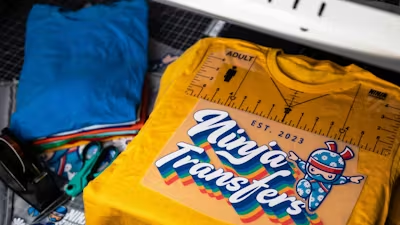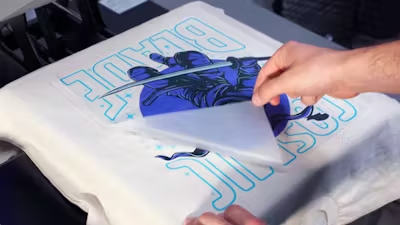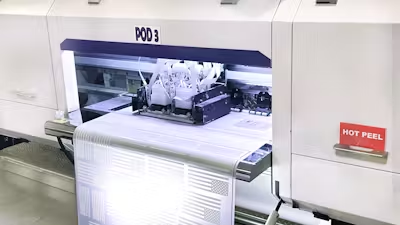Curious about the showdown between DTF transfers and vinyl? We got you. Both methods stem from the long tradition of heat-pressing custom apparel, but they couldn't be more different in execution and results. Vinyl has been the reliable old-school standby for decades, while DTF (Direct-to-Film) is the innovative newcomer transforming the custom printing landscape.
Here's the straightforward truth: DTF transfers outperform vinyl in virtually every category that matters. DTF's capabilities might seem almost magical for those accustomed to vinyl's limitations. Whether you're a small business owner, a print shop professional, or a DIY enthusiast, understanding these differences will revolutionize your custom apparel game.
Let's break down exactly what sets these two methods apart and why DTF is changing everything.

What's the difference? (the short answer)
DTF transfers and vinyl differ fundamentally in both the material and application process. Vinyl is a plastic-based material that's cut into shapes and heat-pressed onto garments. It sits on top of the fabric, creating a distinct layer you can feel. DTF transfers, by contrast, use specially formulated inks printed onto a PET film with a hot melt adhesive that bonds with the fabric when heat-pressed, creating a more integrated print. Learn more about how DTF transfers work.
Most people know vinyl for its use in names and numbers on sports jerseys. While printed vinyl exists (essentially designs printed onto white vinyl and then cut out), it lacks the detail and flexibility of DTF. Vinyl truly shines in special effects-metallic finishes, reflective materials, and fluorescents that DTF can't replicate. However, there are ways to add special effects with DTF.
DTF transfers deliver lighter, more breathable prints with vibrant colors and intricate details. They stretch better with the fabric, withstand more wash cycles, and don't create the dreaded "sweat patch" behind large designs. For most custom apparel applications, DTF transfers are easier to produce, more versatile to apply, more comfortable to wear, and often more cost-effective than vinyl.
Quick comparison: DTF vs. vinyl
Both DTF transfers and vinyl share one key advantage: they can be applied with a heat press, making them an excellent option for print-on-demand (POD) businesses. This accessibility allows anyone with basic equipment to create professional custom apparel without massive investment. But the similarities largely end there.

| Feature | DTF Transfers | Vinyl |
|---|---|---|
| Durability | Excellent - withstands 100+ washes without fading | Good - can crack or peel over time |
| Detail capability | High - reproduces fine lines and gradients | Limited - struggles with intricate designs |
| Color vibrancy | Excellent - full-color photographic quality | Good for solid colors; less vibrant for printed vinyl |
| Hand feel | Good - lightweight with minimal thickness | Poor - heavy and rubbery, especially in large designs |
| Fabric compatibility | Works on almost any fabric | Works on most fabrics |
| Stretch and flexibility | Excellent - moves with the garment | Limited - can crack when stretched |
| Print size | Suitable for any size design | Best for smaller designs; heavy when large |
| Special effects | Limited without combining methods | Excellent - metallic, glitter, reflective, fluorescent |
| Production time | Fast - no weeding required | Slow - weeding process is time-consuming |
| Cost for small runs | Cost-effective | Cost-effective |
| Cost for large runs | Very cost-effective | Less cost-effective due to labor |
| Learning curve | Simple heat press application | Requires precision in cutting and weeding |
This comparison highlights why many businesses are shifting from vinyl to DTF for most applications. While vinyl maintains its edge for certain special effects, DTF offers superior performance across most critical factors. Vinyl will mostly get phased out over time and remain solely for specialized use.

In-depth look: DTF vs. vinyl
Now that we've covered the basics, let's examine both technologies more thoroughly. Their production methods, historical development, and practical applications reveal why they perform so differently in various scenarios. This detailed comparison will equip you to make informed decisions based on your specific printing needs.
Vinyl: The old-school champion
Vinyl heat transfer emerged in the 1980s, revolutionizing personalization for custom apparel. The process starts with sheets of colored polyurethane or PVC film fed into cutting machines - from basic desktop cutters to advanced commercial plotters. These machines precisely cut designs, letters, and numbers based on vector files. After cutting, the excess vinyl (known as negative space) must be manually removed - a labor-intensive process called "weeding" that requires patience and precision.
For decades, vinyl dominated the uniform and sportswear market. In any high school gym, you'll see vinyl names and numbers on jerseys. Its durability against sweat and rough play, combined with perfect opacity on any color fabric, made it the go-to choice for teams everywhere. The material stands up to physical contact and maintains its appearance through countless washes, which explains its enduring popularity.
Despite its strengths, vinyl has notable limitations. Large designs feel heavy and rubbery, creating a stiff effect that doesn't move naturally with the garment. This thickness affects comfort and creates a moisture barrier that traps sweat-the dreaded "sweat patch" that plagues vinyl wearers during physical activity. Additionally, vinyl stretches poorly, often cracking or peeling when the fabric flexes repeatedly.
Where vinyl truly excels is in special effects. The medium offers unique finishes impossible to achieve with other methods: dazzling metallics that catch the light, reflective materials for safety and style, glitter that sparkles with movement, glow-in-the-dark effects, and true fluorescent colors that pop. These specialty vinyls open creative possibilities that even advanced printing methods struggle to replicate.
Vinyl also delivers exceptional color consistency. Unlike other printing methods that approximate colors through CMYK blending, vinyl uses pre-colored materials that match exactly every time. This makes it perfect for brand colors requiring precise Pantone matching, ensuring logos maintain their exact hue across multiple production runs without variation.

DTF: The game-changer
DTF transfer technology emerged around 2020, quickly gaining traction as printers recognized its potential to combine digital printing's detail with heat transfer's versatility. The process starts with specialized printers using pigment-based inks to print designs onto a clear PET film. After printing, a hot melt adhesive powder is applied to the wet ink and cured, creating a transfer that bonds to any fabric when heat pressed. This revolutionary approach eliminated many limitations that plagued earlier printing methods.
Unlike vinyl, which sits distinctly on top of the fabric, DTF transfers integrate more harmoniously with the material. The adhesive fuses with the fabric fibers during heat pressing, creating a print that moves and stretches naturally with the garment. This integration results in a significantly improved hand feel. The difference becomes most apparent in larger designs, where vinyl feels like wearing a plastic bib while DTF remains flexible and breathable.
DTF's digital nature unlocks creative possibilities that vinyl can't match. Photorealistic images, smooth color gradients, minute details, and soft color fades are all easily achievable. Designs can incorporate thousands of colors without increasing production difficulty or cost - a dramatic departure from vinyl's one-color-at-a-time approach. This capability allows for complex artwork reproduction without compromising quality or driving up expenses.
DTF's production efficiency transforms small-business operations. With no weeding required, even complex designs can be prepared quickly. With DTF, a full-color logo that might take 30 minutes to weed in vinyl is ready to press in seconds. These time savings translate directly to business scalability-print shops can produce more in less time, and on-demand fulfillment becomes much more practical. The simplified workflow has made custom apparel production accessible to many who found vinyl's learning curve too steep.
DTF's durability revolutionized expectations for heat-applied graphics. Independent testing demonstrates that properly applied DTF transfers can withstand over 100 wash cycles while maintaining color vibrancy and adhesion. Unlike vinyl, which tends to crack after repeated stretching, DTF maintains its flexibility throughout the garment's life. This combination of visual quality and longevity has made DTF the preferred choice for businesses concerned with reputation and customer satisfaction.

The future belongs to DTF
The verdict is clear when comparing DTF transfers to vinyl: DTF has eclipsed vinyl in nearly every meaningful metric. For detailed graphic designs, photorealistic prints, and even the once-untouchable territory of names and numbers, DTF delivers superior results with less work. With gang sheet setups, you can efficiently produce multiple transfers in a single print run, making the process even more cost-effective. The prints remain vibrant, flexible, and comfortable through hundreds of washes.
Vinyl still holds its ground in one notable arena: specialty finishes. When your design demands the flash of metallic foil, the visibility of reflective material, or the punch of a true fluorescent color, vinyl remains your go-to option. But for everything else-from team uniforms to branded merchandise, from photo prints to detailed logos-DTF transfers offer the perfect balance of quality, durability, comfort, and efficiency.
Ready to experience the DTF difference? Ninja Transfers provides high-quality DTF transfers that arrive ready to heat press onto your favorite blanks. Pair them with premium garments from Ninja Blanks for custom apparel that looks professional and feels exceptional. Your customers won't just see the difference-they'll feel it.






































